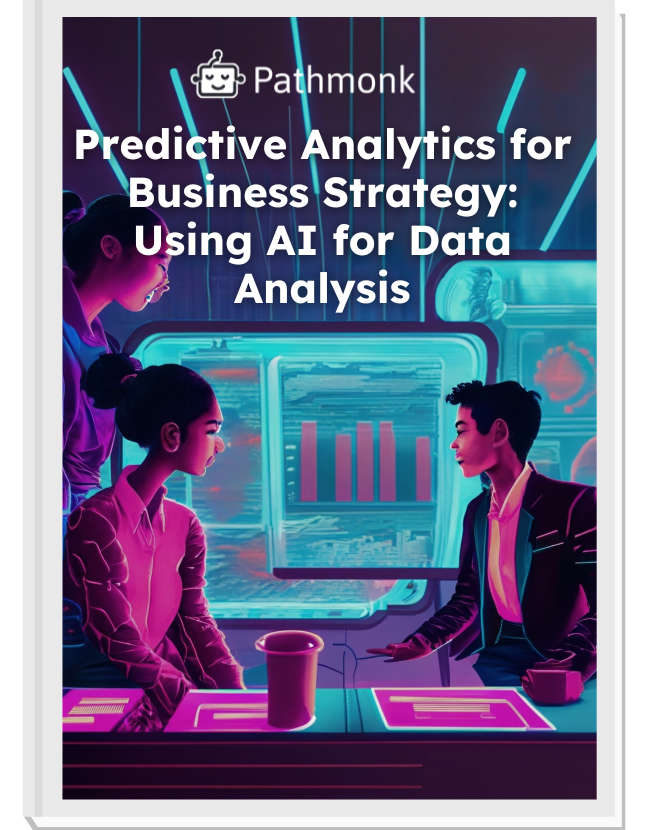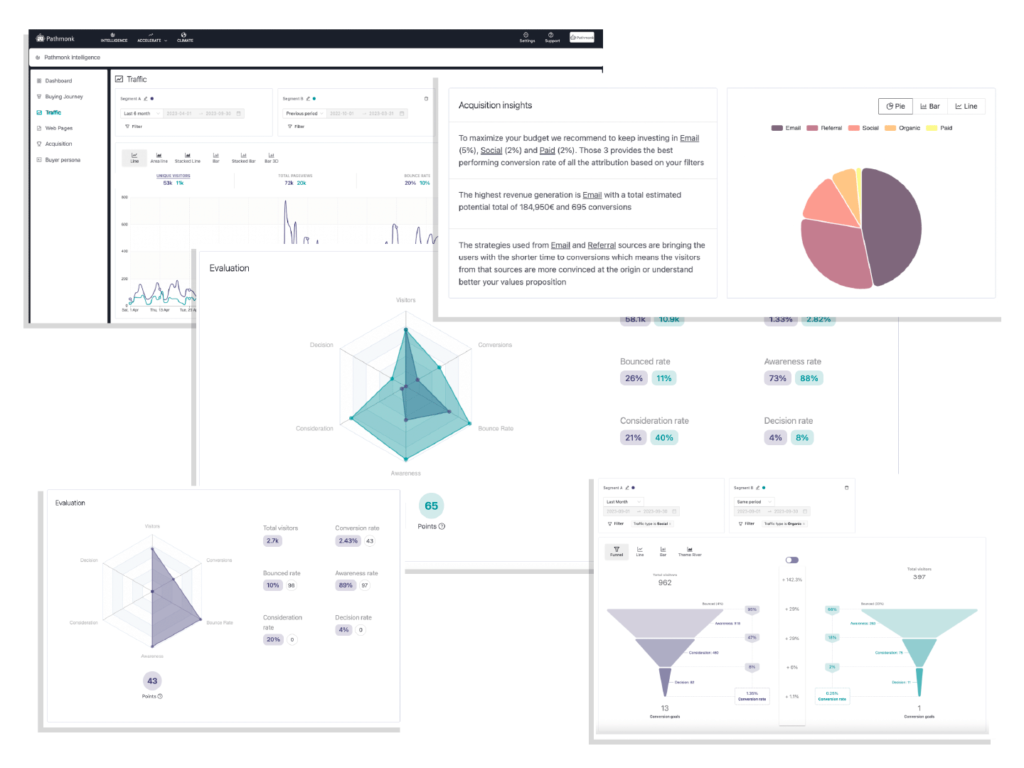
Today understanding customer behavior is A MUST. So for that reason, we are about to get into behavioral data in marketing. Hope you have heard about it, but just in case we´ll give you all the details.
To begin with, what is considered behavioral data is all the information collected about the actions and behaviors of consumers as they interact with a brand or product. This type of data is crucial in understanding how consumers engage with marketing materials, websites, products, and services.
Table of Contents
Why Should Marketers Use Behavioral Data?
Marketers like yourself should use behavioral data for several strategic reasons, as it provides insights that are crucial for optimizing marketing efforts and achieving better business outcomes. Here are some compelling reasons why you will benefit from using it:
1. Targeted Marketing Campaigns: Behavioral data enables you to understand the preferences, needs, and habits of their customers. This knowledge allows for creating highly targeted and personalized marketing campaigns that speak directly to the interests of different customer segments, increasing engagement and conversion rates.
2. Enhancing Customer Experiences: By analyzing how customers interact with products and marketing content, you´ll be able to identify points of friction and opportunities to enhance the customer journey. This leads to improved customer satisfaction and loyalty, as experiences are tailored to meet and exceed expectations.
3. Optimizing Content and Offers: this data also shows what types of content and offers are most effective with various audience segments. Use this information to optimize your messaging and promotional strategies, ensuring that they deliver the right message at the right time.
Ebook: Predictive analytics for business strategy
Dive deep into the future of business intelligence and learn how to leverage AI for strategic advantage.

4. Increasing Return on Investment: With behavioral data, you can more effectively allocate your budgets to the channels and strategies that deliver the best results. This data-driven approach minimizes wasted spend and maximizes ROI by focusing resources on proven tactics.
5. Predicting Future Behaviors: Advanced analytics and machine learning models can use behavioral data to predict future customer actions, such as likelihood of purchase, potential churn, or response to upcoming campaigns. This predictive capability allows you to proactively address issues and seize opportunities, staying one step ahead in your strategies.
6. Improving Retention Strategies: Behavioral data helps identify patterns that indicate customer loyalty or risk of churn. You can use this information to implement effective retention strategies, targeting at-risk customers with special offers or personalized content to keep them engaged.
7. Refining Product Development: Insights from behavioral data are not only useful for marketing but also for informing product development. Understanding how customers use and interact with products can guide improvements and innovations, ensuring that new offerings are well-received and meet market demands.
8. Enhancing Competitive Advantage: In a competitive marketplace, leveraging behavioral data can give companies an edge by enabling more responsive and customer-focused strategies. This not only attracts new customers but also builds deeper relationships with existing ones.
9. Data-Driven Culture: Employing behavioral data fosters a culture of data-driven decision-making within marketing teams. This culture encourages continuous learning and adaptation, which are crucial for long-term success in dynamic market environments.
By leveraging behavioral data, you can achieve a deeper understanding of your customers, refine their strategies, and deliver more effective and efficient marketing efforts that drive business growth.
Types of Behavioral Data in Marketing
Behavioral data is categorized based on the type of customer activities or interactions tracked. Here are several key types of behavioral data commonly used in marketing:
- Web Browsing Data: This includes details about how users interact with a website, such as the pages they visit, the time they spend on each page, the links they click, and their navigation path through the site.
- Purchase History: Information on what customers have bought in the past, including frequency of purchases, the amount spent, and the types of products or services purchased. This data is crucial for understanding buying patterns and preferences.
- Social Media Engagement: Data gathered from social media platforms, detailing how users interact with a brand’s posts, including likes, shares, comments, and direct messages. This also encompasses the analysis of sentiment and trends within these interactions.
- Email Interaction Data: Metrics from email campaigns, including open rates, click-through rates, and conversion rates. This data can help you understand which email content engages customers best.
- Mobile App Usage: Insights from how users interact with a mobile application, including the features they use most, session length, and in-app purchases. This can also include location data if the app has location services enabled.
- Video Engagement: Detailed analytics from video content, such as the number of views, average watch time, likes, and shares. This also includes how much of a video is watched and at what point viewers tend to drop off.
- Ad Interaction Data: Data on how users interact with online advertisements, including clicks, impressions, and conversions. This helps in understanding the effectiveness of different ad formats and placements.
- Customer Service Interactions: Information from customer support interactions, whether through chat, email, or phone. Analyzing this data can provide insights into common issues, customer satisfaction levels, and service effectiveness.
- Device Usage: Information about the devices used by customers to interact with a brand, such as whether they are using a smartphone, tablet, or desktop computer, and the operating system and browser used.
- Search Data: Data on what terms customers are searching for on a website, which can indicate what products or information they are interested in.
Ethical Considerations
However, using behavioral data raises several ethical considerations that organizations must address to maintain trust and comply with legal standards.
- Privacy and Consent: One of the most significant ethical considerations is the privacy of individuals. Organizations must obtain explicit consent from users before collecting and using their behavioral data. Users should be fully informed about what data is being collected, how it will be used, and with whom it will be shared.
- Data Security: Protecting the data collected is paramount to prevent unauthorized access and breaches. Ethical handling of behavioral data involves implementing strong security measures to safeguard personal information and minimize the risk of data leaks or theft.
- Transparency: Your organization must be transparent about its data collection practices. This includes clear communication about the types of data collected, the purposes for which it is used, and the rights of individuals regarding their data. Transparency builds trust and ensures that consumers feel secure in their interactions with a brand.
- Data Minimization: Ethically, companies should only collect data that is necessary for the defined purposes. Collecting excessive data can lead to potential misuse and raises concerns about why unnecessary data is being gathered in the first place.
- Bias and Fairness: Behavioral data can be biased, especially if the data set is not representative of the entire population. This can lead to unfair practices or decisions that disproportionately affect certain groups. Ethical use of behavioral data requires continuous monitoring and correction for biases.
- Accountability: Organizations should be accountable for their use of behavioral data. This includes having policies in place for responsible data handling and being prepared to answer to regulatory authorities and the public about data practices.
- Respecting User Preferences and Rights: Beyond initial consent, ethical data use involves respecting user preferences and rights over time. This includes allowing users to access their data, correct inaccuracies, and request the deletion of their data if they no longer wish to engage with the organization.
- Use of Data for Appropriate Purposes: Organizations must ensure that behavioral data is used for legitimate, ethical purposes and not for manipulating, deceiving, or unfairly targeting consumers.
- Compliance with Laws and Regulations: Ethical use of behavioral data also means complying with all applicable laws and regulations, such as the General Data Protection Regulation (GDPR) in the European Union, the California Consumer Privacy Act (CCPA), and other regional and international frameworks.
What Is the Best Tool for Capturing and Analyzing Behavioral Data?
Pathmonk Intelligence is a tool specifically designed to help marketers enhance their website’s performance by leveraging behavioral data. Here’s how Pathmonk uses this data:
- Real-time Visitor Insights: Pathmonk provides real-time insights into visitor behavior on a website. It tracks how users interact with various elements of the site, such as how long they hover over a specific product or how quickly they scroll through content. This allows marketers to understand user intent and engagement levels.
- AI-Driven Recommendations: Our tool uses artificial intelligence to analyze behavioral data and make recommendations for optimizing website elements to increase conversion rates. This might include suggestions on where to place call-to-action buttons or how to structure content to keep users engaged longer.
- Conversion Rate Optimization: By understanding the behaviors that lead to conversions, Pathmonk helps marketers focus on what works. It identifies the most effective paths through the website that lead to sales or other desired actions, allowing for targeted improvements.
- Personalized User Experiences: Based on the behavioral data collected, Pathmonk can personalize the experience for each visitor. This personalization is geared towards increasing the likelihood of conversion by presenting the most relevant content and offers to each user.
- Analytics and Reporting: Pathmonk provides detailed analytics on user behavior, conversion paths, and overall site performance. This data helps marketers measure the impact of their optimizations and further refine their strategies.
Intuitive Cookieless Analytics for Your Web
Understand your customer journey, find drop-offs, and receive actionable insights with AI.

To Wrap Up
Things to remember from this post? Behavioral data in marketing tracks consumer interactions with brands, helping marketers like you optimize campaigns, personalize experiences, and enhance user engagement. But don’t forget the ethical considerations, which also include ensuring privacy, transparency, and security. Try out tools like Pathmonk Intelligence which utilizes AI to analyze this data, offering insights for improved conversion rates. Essentially, behavioral data is integral for tailoring marketing strategies effectively to consumer behaviors.





